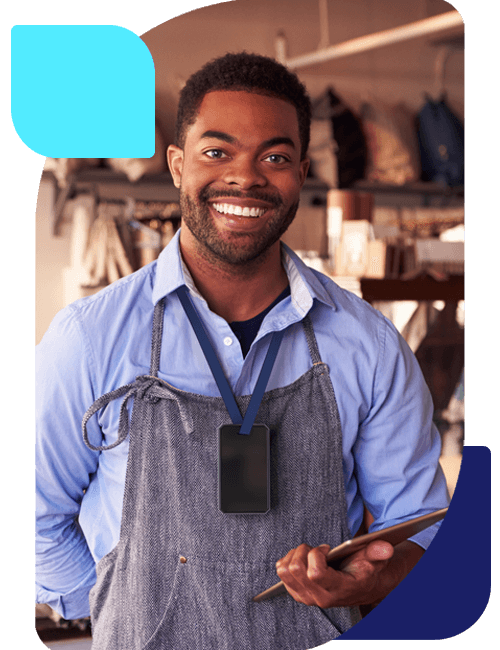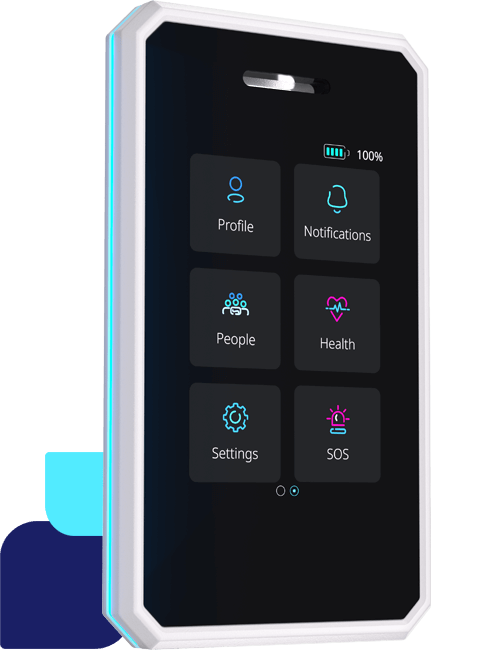There are many difficulties that come with using a voice-only communication system in a medical setting. In this article, we are going to explore some of the questions that research has raised, such as this article by Tang & Carpendal, which explores the use of Vocera within a healthcare environment. The study raises several good points, but left me with questions such as, are there better ways to improve communication and cooperation in healthcare? We’re going to try to compare whether a messaging solution is a better choice.
Why healthcare has introduced voice systems
Innovation is a mysterious creature which comes in many different forms. Some innovations stick, some don’t. Remember MP3 players? Their standalone functionality became obsolete when more comprehensive solutions came along, which I’m sure many of us use today: smart phones.
Healthcare organisations have begun implementing voice communication solutions to try and improve coordination and collaboration. It’s my opinion that it won’t be long until standalone voice systems become (like the mp3 player) are for niche use only, replaced by systems integrated with more functionality, better suited for the use of the majority of staff.
Hardware VOIP Wi-Fi Systems Vs. standard 4G LTE-M Messaging
One of the most popular voice communication systems for healthcare workers, is some sort of VOIP (Voice over internet protocol) communication system. But VOIP systems usually rely on Wi-Fi to work.
Standard 4G LTE-M isn’t the only alternative to using Wi-Fi only, but is a good point of comparison. When considering set up costs, 4G LTE-M usually requires employees to be given a device. Wi-Fi based systems, which have a much smaller radius of connectivity (which can mean poor reception when further away from Wi-Fi routers), tend to have more hardware requirements and larger set-up costs across sites such as hospitals, or care homes.
In the case of, while the system in question – Vocera – undoubtedly brought certain benefits to some healthcare workers, the devices being assessed only connected to other Vocera devices on the network. Meaning if a user wanted to call someone on another network, or without a Vocera device, they had to use a separate device or physically go and find them. Hardly ideal for busy employees who already have several devices to manage. By comparison, using 4G LTE-M allows messages to be sent to any Sense device on any network within the organisation – providing they have reception. Cellular based devices also have the additional flexibility of being able to be used off-site or at other sites, without having to commission with other networks.
Some of the problems that also came with this system, included problems with the system understanding accents. Healthcare settings regularly employ staff from diverse backgrounds who would be expected to use the system as part of their working day. As the voice-only system didn’t allow text input, it meant that users had to say aloud who they wanted to call. That’s a lot of names to remember. People who pronounced the names with an accent that the system hadn’t been trained to recognise, often met system errors. This led to employees reverting to face-to-face conversations or using an alternative device such as a telephone at the nurse’s station.
These issues could be eliminated by text-based messaging. There’s no need for messaging systems to interpret accents, or voices in noisy environments. Messages can be read when convenient to do so, while a voice call is either answered, or not. It’s also worth noting that a voice call could easily be disrupted by others talking, or other noise interference.
Do voice-only systems improve cooperation for healthcare workers?
There are several ways to improve communication for healthcare workers. On the surface, voice communication is the fastest and most direct way to talk to a Colleague. But when implementing a new system to improve communications, it’s important to consider the environment it’s used in, and the needs of the employees and patients – something that the aforementioned research also picked up on.
A voice only system needs to be able to connect all employees. Creating silos where teams can only speak to one another via devices will likely lead to issues, such as the need for multiple devices for separate wards to cooperate. That said, it’s also not sensible to open a massive directory of names and numbers to each and every colleague who simply has no use for communications outside of their team. Therefore, a device which has the capability to connect all, but which is also configurable on an individual level to create the perfect level of connectivity, could well be the best choice.
Not only this, but voice-only systems can’t be used to page doctors. As a result, other systems end up being used instead. Plus, the study found that it’s often difficult to reach nurses during shift handovers on voice-only systems, especially when employees forget to log-in, rendering them uncontactable for that time. And lack of location awareness with voice only systems make it difficult to know who to call, if you’re looking for the nearest person available to help, for example.
These challenges, combined with the voice recognition issues already mentioned, can create a blocker for improving cooperation – difficulty understanding accents, fighting for attention against other noises (especially at a busy nurse station), and being unable to locate people can make it difficult to cooperate with colleagues.
However, the study noted that voice-only systems do have some benefits in a healthcare setting.
For example, the time saved when systems work as designed, helps nurses spend more time with patients. The ability to leave notes to self as reminders also made a positive difference.
In the instance of the research conducted by Tang & Carpendale, the nurses being observed only had the ability to only call other workers on their ward. A benefit of this limited scope, was to help them focus in on cooperating as a smaller unit, as opposed to being distracted by unnecessary calls from other units.
Can voice only systems improve information sharing?
In the current day and age, data security is front of mind for most organisations. Voice-only communication systems don’t offer much in the way of patient privacy, or confidentiality. There’s no way to really know who’s on the other end of the line, especially if you’re calling someone you’ve not spoken to before. It’s also difficult to protect from eavesdropping.
On top of privacy concerns, clarifying specific information or instructions can be difficult in noisy environments, or if distracted by other goings on. Most healthcare workers will meet face-to-face to discuss lengthy topics, or complex information. This is demonstrated in ward handovers where nurses will usually gather around the nurse’s station to discuss patient handover and exchange important information about care needs and what’s left to do.
Another difficulty is providing location information over voice-only calls. This problem is worsened when talking to someone who doesn’t know the area. There are systems which can provide real time location information, as well as instant messaging communication, such as Sense – a modern solution that provides wearable tech for frontline workers.
However, it’s not all doom and gloom for voice only systems. Voice-only communications do have some benefits when used properly, in the right environments when it comes to sharing information. Brief Q&A’s can be sped up over voice-only (providing the call is answered) meaning help can be found quickly for minor problems, or to clarify simple information.
Receipt of a message can be verbalised over voice-only calls, eliminating uncertainty if a note is left on a board in the ward, or in patient notes. Organising breaks, or lunches can be made simpler too over voice-only communication systems, especially in a healthcare environment, so you can check quickly if someone is available, or on a break.
Voice-only systems tend to be used for work purposes only, meaning social comms are saved for in person. This means patients, or other employees are less likely to overhear employee chatter that they don’t want to be subject to, and work-related information is easier to get without being dilated or interrupted by unrelated information.
Do voice only communication systems create a better workplace?
Some healthcare organisations might think voice only communication systems will make their workplace more difficult to manage, and they might have good reasons to believe that. Interruptions in employees’ ears, generally noisy environments, as well as dead spaces with no connection are just three reasons why voice only systems might not be right for use.
And the list goes on. Echoes and feedback caused by machines is also a problem that healthcare organisations are having to face when using voice only systems. It’s also important to remember there are instances where employees will need to put devices on mute, such as when on break, or during important conversations with patients. This can lead to missed calls or help requests.
Difficulty with sharing location over voice only communication systems is another point to take into consideration. Calls are not routed to the nearest help available, and you’ll need to physically locate someone when the system fails you. You’ll require additional location technology if you choose to use both voice-only systems, and location systems, separately.
However, there are ways in which voice only can improve the workplace, making it better for employees and management alike. For example, employees won’t need to travel as far, as often, when connected to their team who they can communicate with from anywhere, if they have signal. This means over large spaces teams can share information and increase their productivity without having to physically go looking for one another.
Voice-only communication systems mean that patients are far less likely to be subject to overhead broadcasts from public address system. This means employees don’t have to hear the distracting broadcasts either. This helps contribute to quietening wards, reducing mass distractions, and making communications received more relevant, improving overall patient and employee experience.
In addition, employees won’t have to shout across wards, either.
Do voice only communication systems improve communication and patient care?
Communication is best served concise, whilst relevant, and uninterrupted. Voice only communication systems can help employees to focus on spending more time on patient care, improving the overall experience for employees and patients alike. Reducing interruptions from colleagues knocking on doors or peeping around curtains is one benefit of carrying a voice-only device – it means you can set it to mute and focus on the task at hand. Once the task is finished, employees can return to being reachable, helping them and their colleagues save time searching for one another to share information or complete other tasks.
But there are some drawbacks for voice-only communication systems that don’t improve communication, or patient care, which it’s important to be aware of.
On top of time consumed to set up and search through a phone book, users noted that VOIP can be laggy and is not always instantaneous. Also, voice calls are slower than natural face-to-face speech, especially if systems are walkie-talkie style where colleagues must wait for one another to finish speaking before asking for clarifications. It can also be difficult to establish availability of colleagues whilst using small handheld devices (some office-based voice only communication systems show availability but require larger screens and are often fixed to desks – not particularly suited to healthcare environments).
And from a purely data processing standpoint, some organisations are concerned by the fact that voice files are bigger than text files. Voice notes or saved call files require extra storage, which could cost the company more, relative to an instant messaging service. If you’re weighing up between a real time location-based instant messaging service and a voice only communication system, it’s also worth noting that help requests on a voice only system might not go to the nearest available help in an emergency – this would require location intelligence.
Voice only communication system vs. messaging systems
Many healthcare organisations have considered implementing technology to help improve cooperation and information sharing, trying to make a better workplace overall. As we’ve discussed throughout this article, voice only communication systems have some benefits, although some issues which may mean it’s not quite suitable for healthcare use.
If you’re using a telephony service alongside your VOIP system, you can call outside of the small network of devices in the workplace. Although, this does come at extra expense. You can broadcast to groups over voice, or to individuals, as well as get immediate clarification for your questions.
Voice communication is synchronous, eliminating uncertainty about responses, and confirming receipt of message immediately if speaking to an individual. You can report on usage if using a system such as Vocera, and help to reduce the need for public address systems.
On the flipside, voice messages can be ignored if broadcast to a group, and intercoms/public address broadcasts can be treated as ambient noises. This can lead to individuals exaggerating panic or importance to ensure they get a response.
The other challenge for voice systems is how do you locate people? There’s no way of knowing who is nearest to help you out. Voice systems can make your technology stack expensive as they have limited functionality. Voice systems also struggle with accents, aren’t great to use with gloves, and aren’t truly hands free. WiFi can be slow to relay voice, where most employees in healthcare would prefer instant communication without lag.
Real time location & communication systems such as Sense have a wealth of functionality that voice only communication systems can’t compete with. Knowing the location of who you’re communicating with in a healthcare environment helps to tailor the communications, such as the information you share, the urgency of the message, and the relevance to the individual or group who are receiving.
Although asynchronous, instant messaging allows healthcare employees to further remove noise from already noise polluted environments by typing & reading instead of speaking aloud. This also improves patient confidentiality in ward, or care home environments.
It’s much easier for management to send tasks and alerts (as well as assign breaks and lunches), to relevant individuals without having to broadcast to, and potentially deliberate with the team when they know exactly who started when, where they currently are, and whether they’re in the middle of something. Messaging systems are less likely to disrupt an employee than a voice call if they forget to mute their device or if they are on their break. It’s also important to note messaging systems are less susceptible to interference, feedback or echoes, or problems interpreting employee input.
So, before opting for a voice-only system, think about what else your frontline staff need to do their jobs more effectively. If you would like to help them be better organised and use location intelligence to find the right people, then platforms such as Sense could help you deliver a significantly better service.







